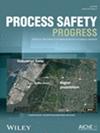Hydrogen safety effect calculation (dispersion and thermal radiation effects) for determination of siting and safe distance
IF 1
4区 工程技术
Q4 ENGINEERING, CHEMICAL
引用次数: 0
Abstract
The main aim of this study was to evaluate the potential effect of dispersion, thermal radiation, and explosion from a poly-bed pressure swing adsorption (PSA) unit with its surrounding facility to determine its safety distance. Thus, the Shell FRED (fire, release, explosion, and dispersion) consequence modeling was used to predict the impact of a release scenario and assist in designing, developing, and maintaining safe operation. This study was intended to calculate dispersion contours to 50% lower flammable limit (LFL) and 100% LFL, thermal impacts of radiation flux levels of 4, 5, 12.5, and 37.5 kW/m2 at a distance, and including explosive effects of 0.1, 0.2, and 0.35 bar to the chosen target. Based on the findings, it was found that, to avoid exposure to heat radiation of 12.5 kW/m2 from the PSA unit, equipment should be located at a minimum distance of 20.84 m. Meanwhile, process modules and buildings must be located at a minimum distance of 13.8 m. The explosive nature of hydrogen makes on-site handling and storage more challenging than fossil fuels. The findings of this study will have important implications for the future handling and storage of hydrogen as a potential fuel.氢安全效应计算(扩散和热辐射效应),用于确定选址和安全距离
本研究的主要目的是评估多床变压吸附(PSA)装置及其周围设施的扩散、热辐射和爆炸的潜在影响,以确定其安全距离。因此,壳牌公司的 FRED(火灾、释放、爆炸和弥散)后果模型被用来预测释放情景的影响,并协助设计、开发和维护安全运行。这项研究旨在计算 50%易燃下限 (LFL) 和 100%易燃下限的扩散等值线,4、5、12.5 和 37.5 kW/m2 距离的辐射通量水平的热影响,以及 0.1、0.2 和 0.35 巴对所选目标的爆炸影响。研究结果表明,为避免受到来自 PSA 设备的 12.5 kW/m2 热辐射,设备的最小距离应为 20.84 米。同时,工艺模块和建筑物之间的最小距离必须为 13.8 米。与化石燃料相比,氢气的爆炸特性使得现场处理和储存更具挑战性。这项研究的结果将对未来处理和储存氢这种潜在燃料产生重要影响。
本文章由计算机程序翻译,如有差异,请以英文原文为准。
求助全文
约1分钟内获得全文
求助全文
来源期刊

Process Safety Progress
工程技术-工程:化工
CiteScore
2.20
自引率
10.00%
发文量
99
审稿时长
6-12 weeks
期刊介绍:
Process Safety Progress covers process safety for engineering professionals. It addresses such topics as incident investigations/case histories, hazardous chemicals management, hazardous leaks prevention, risk assessment, process hazards evaluation, industrial hygiene, fire and explosion analysis, preventive maintenance, vapor cloud dispersion, and regulatory compliance, training, education, and other areas in process safety and loss prevention, including emerging concerns like plant and/or process security. Papers from the annual Loss Prevention Symposium and other AIChE safety conferences are automatically considered for publication, but unsolicited papers, particularly those addressing process safety issues in emerging technologies and industries are encouraged and evaluated equally.
 求助内容:
求助内容: 应助结果提醒方式:
应助结果提醒方式:


